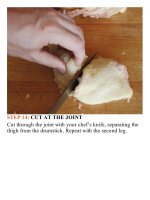The food lab better home cooking through science ( PDFDrive ) 53
Bạn đang xem bản rút gọn của tài liệu. Xem và tải ngay bản đầy đủ của tài liệu tại đây (154.57 KB, 2 trang )
relentlessly macho), I made the switch and saw an
immediate and dramatic improvement in my knife
skills. I’m not one to judge someone based on how
they hold their knife (or if I did judge, I’d do it
silently),buthere’sthedeal:Ifyou’veonlyeverused
thehandlegrip,givethebladegripatry—youmay
find your cuts improving dramatically. In return, I
promisetojudgeyouonlyslightlyifyougobackto
usingthehandlegrip.
What about your non–knife hand? In general,
therearetwopositionsyou’llfindthathandin.The
most common is known as “the claw,” and when
people cut themselves with a knife, it’s mostly likely
because they weren’t using the claw. Use this grip
when dicing and slicing. Protect the fingertips of
your non-knife hand by curling them inward, using
your knuckles to guide your knife. When cutting
food, always place itin a stable position, preferably
with a cut surface flat against the cutting board.
Then guide the knife blade against the food with
yourclawhand.
For mincing, a different approach is required.
Place the tip of your knife on the cutting board and
holditinplacewithyourfreehand.Rocktheblade
upanddowntoreduceherbs(oranythingelse)toa
finemince.
EASTVERSUSWEST:









